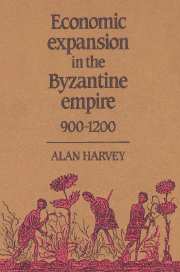Book contents
6 - Interaction between town and country
Published online by Cambridge University Press: 06 August 2010
Summary
The history of Byzantine towns has been discussed too often in isolation from the broader social context which links town and country closely. Towns were very sensitive to developments in the rural economy affecting agricultural production. They cannot be defined as independent entities outside the economy and society of which they were a part. A precise definition of a town cannot be given easily owing to the multiplicity of functions which it could perform – as a religious centre, a judicial centre, a fortified place for defince, a market, a central place offering services to a rural hinterland. A purely economic definition would stress occupational specialisation in crafts and industry, a role which separated an urban population from rural agricultural producers.
It is impossible to postulate with confidence any minimum population for an urban centre because towns are defined by function rather than size. Many towns in medieval Europe were smaller than large villages, but they were distinguished from them by their non-agricultural activities. Before 1500 the vast majority of towns in the west had less than 2,000 inhabitants. Braudel estimates the average population of the 3,000 settlements with civic status in Germany at 400. Figures for Byzantine towns are lacking. We do know that there were at least 163 adult males in Lampsakos in 1219, which suggests a likely population of 600–750 if the entire adult population was recorded. However, it will be argued later that Lampsakos is not a good case from which to generalise.
Figures from the Ottoman period show how limited the population of towns might have been. Serres was the site of various representatives of the Porte supervising the fiscal administration, coinage-minting and economic activities.
- Type
- Chapter
- Information
- Economic Expansion in the Byzantine Empire, 900–1200 , pp. 198 - 243Publisher: Cambridge University PressPrint publication year: 1990



